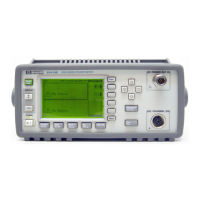2-20 Chapter2
Getting Started
Making a Measurement
Making a Measurement
Let’s begin using the analyzer by measuring an input signal. Since the
internal 50 MHz amplitude reference signal is readily available, we will
use it as our test signal.
NOTE You cannot hurt the analyzer by using this reference signal and
pressing any of the keys described in this section. Don’t be afraid to
play with the knob, step keys, or numeric keypad. (If you have
experimented with other keys and wish to return to a known state,
press the green Preset key and, if present, the Factory Preset menu key.)
1. First, turn the instrument on by pressing
On. Wait for the power-up
process to complete.
2. Press System, Power On/Preset, Preset (Factory).
3. Press the green
Preset key. Turn on the internal 50 MHz signal by
pressing
Input, Amptd Ref Out (f=50 MHz) (On) and connecting a cable
from the
AMPTD REF OUT to the INPUT 50 Ω.
NOTE For the Agilent E4401B and E4411B, the above key label is Amptd Ref
(f=50 MHz), and no cable is required.
4. Set the frequency.
Press the
FREQUENCY Channel key. Center appears on the left side
of the screen, indicating that the center-frequency function is active.
The
Center Freq menu key label is highlighted to indicate that center
frequency is the active function. The active function block is the
space on the screen within the graticule where the active function
messages appear. Active function values can be changed using the
knob, step keys, or numeric keypad. Set the center frequency to
50 MHz with the DATA keys by pressing
50 MHz. The knob and step
keys can also be used to set the center frequency.
CAUTION When operating in DC coupled mode on spectrum analyzers with
Option UKB, take care to protect the input mixer by limiting the input
level to 0 VDC and +30 dBm.
5. Set the span.
Press
SPAN X Scale. Span is now displayed in the active function
block, and the
Span menu key label is highlighted to indicate it is the
active function. Reduce the span to 20 MHz by using the knob,
pressing the down key (⇓), or pressing
20 MHz.

